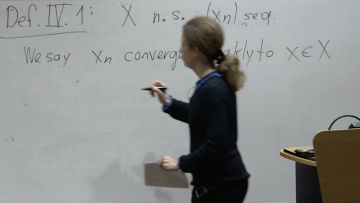Representable Markov Categories and Comparison of Statistical Experiments in Categorical Probability
Fritz, T
Gonda, T
Perrone, P
Rischel, E
(14 Oct 2020)
Kan extensions are partial colimits
Perrone, P
Tholen, W
(12 Jan 2021)
De Finetti's Theorem in Categorical Probability
Fritz, T
Gonda, T
Perrone, P
(06 May 2021)
Dilations and information flow axioms in categorical probability
Fritz, T
Gonda, T
Houghton-Larsen, N
Lorenzin, A
Perrone, P
Stein, D
(04 Nov 2022)
Weakly Markov categories and weakly affine monads
Fritz, T
Gadducci, F
Perrone, P
Trotta, D
(24 Mar 2023)
Representable Markov categories and comparison of statistical experiments in categorical probability
Fritz, T
Gonda, T
Perrone, P
Rischel, E
Theoretical Computer Science
volume 961
113896
(Jun 2023)
Absolute continuity, supports and idempotent splitting in categorical probability
Fritz, T
Gonda, T
Lorenzin, A
Perrone, P
Stein, D
(01 Aug 2023)
We have just put our 100th student lecture on YouTube. But you can watch them all in one minute below.
Or, alternatively, in about 80 hours via our Student Lectures playlist.
Utilising an in silico model to predict outcomes in senescence-driven acute liver injury
Ashmore-Harris, C
Antonopoulou, E
Aird, R
Waters, S
Nature Regenerative Medicine
volume 9
issue 1
(30 Sep 2024)
Sensitivity of cartilage mechanical behaviour to spatial variations in material properties
Whiteley, J
Brown, C
Gaffney, E
Journal of the Mechanical Behavior of Biomedical Materials
volume 156
(13 May 2024)


